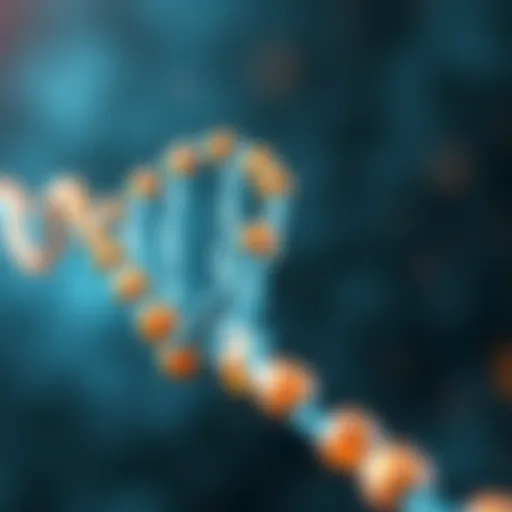Free Online Certificate Courses in Bioinformatics


Intro
In today’s world, bioinformatics stands out like a lighthouse in the fog for both researchers and professionals. With its roots deeply embedded in biology, computer science, and statistics, this field is essential for analyzing biological data. It’s not just for the scientists in lab coats anymore; students, healthcare providers, and lifelong learners are diving into this field as well, pushing the barriers of knowledge.
The surge of free online certificate courses has made this valuable educational resource accessible to anyone eager to learn. Each course is a gateway, offering a structured path through complex topics such as genomic data analysis, proteomics, and computational biology. As institutions realize the importance of bioinformatics in the lives of medical professionals and researchers, many are stepping up to provide these courses that fit snugly in a busy schedule.
Growing interest in personalized medicine, genomics, and data-driven decision-making in healthcare means that acquiring bioinformatics skills can be a game-changer. So, let’s sift through the recent strides made in the field, the courses available, and how this educational pathway can transform careers and fuel scientific advancements.
Prolusion to Bioinformatics
Bioinformatics has woven itself into the fabric of modern biological sciences, becoming a critical player in decoding the complexities of life. With the advent of advanced technologies in sequencing and data processing, bioinformatics allows researchers to manage and analyze vast amounts of biological data. The significance of this field lies not only in its capacity to handle data but also in its ability to transform raw biological information into meaningful insights that can advance research and application in medicine, agriculture, and beyond.
Definition and Scope
Bioinformatics can be described as the intersection between biology, computer science, and information technology. It encompasses a range of tools and techniques aimed at understanding biological data through computational methods. This includes gene sequencing, where algorithms help analyze genetic material, to systems biology, which studies and models complex interactions in biological systems. In simple terms, bioinformatics turns biological data into knowledge, helping scientists discover new patterns or connections that were previously hidden.
The scope of bioinformatics is immense. It not only assists in genetic analysis but also plays a vital role in pharmacogenomics, where individual genetic profiles guide drug development and therapy. Bioinformatics extends to areas such as population genetics, evolutionary biology, and even ecological studies. As a result, anyone interested in these realms can benefit from a strong foundation in bioinformatics.
Historical Background
The roots of bioinformatics can be traced back to the 1960s when the need to analyze biological data began to emerge. One of the first significant milestones was the introduction of the concept of a biological database. In the years that followed, both the technology and the necessity for computational biology grew in tandem.
By the late 20th century, databases such as GenBank and the European Molecular Biology Laboratory (EMBL) had been established to store genetic sequences, providing researchers with essential resources. The completion of the Human Genome Project in the early 2000s marked a significant turning point in bioinformatics, leading to an explosion of data and the development of new algorithms to process this data effectively.
As we moved into the digital age, bioinformatics entered a new phase characterized by rapid advancements in technology, artificial intelligence, and machine learning. These developments have allowed bioinformaticians to not only store and process data but also analyze and interpret it at unprecedented levels. Today, bioinformatics sits at the forefront of research, actively driving innovations in personalized medicine, cancer research, and understanding complex diseases.
"Bioinformatics is like a bridge, connecting vast islands of knowledge across biology, chemistry, and informatics, allowing us to travel quickly among them.”
The Importance of Bioinformatics
Bioinformatics stands as a key player at the crossroads of biology and technology, enabling significant advancements across various scientific disciplines. Its relevance is not limited to just one aspect; it encompasses a plethora of applications that impact genomic research and personalized medicine significantly. Understanding the importance of bioinformatics is crucial, especially in the rapidly evolving landscape of science, where data drives innovation.
Role in Genomic Research
Genomic research has seen an explosion in data due to advancements in sequencing technologies. Here, bioinformatics is pivotal. It provides the necessary tools to analyze huge volumes of data effectively. The field applies computational techniques to decipher DNA sequences, identifying genes, mutations, and other critical elements in the genome. As researchers dive deep into intricate genetic codes, bioinformatics simplifies the complex by organizing, storing, and analyzing this information.
- Data Management: Organizations like the National Center for Biotechnology Information (NCBI) have voluminous databases that require sophisticated tools to manage and retrieve genetic information. Bioinformatics helps to create a structured approach, allowing for effective data accessibility and analysis.
- Comparative Genomics: Through bioinformatics, scientists can compare genetic material among different species, which aids in understanding evolutionary biology and functional genomics. This comparative study opens windows to identify conserved genes that may play roles in fundamental biological processes.
A prominent example is the Human Genome Project, which relied heavily on bioinformatics for data analysis. The project's success not only contributed to our understanding of human genetics but also paved the way for new research avenues.
Impact on Personalized Medicine
Personalized medicine is another sector where bioinformatics shines. It tailors treatments to individual patients based on their genetic profiles, moving far beyond a one-size-fits-all approach. This shift enables healthcare providers to prescribe treatments that are likely to be more effective.
- Pharmacogenomics: By analyzing genetic variations that affect drug metabolism, bioinformatics plays a crucial role in pharmacogenomics. For instance, a patient with a specific genetic marker might respond better to certain drugs over others. This knowledge translates into smarter, safer prescribing practices, minimizing adverse drug reactions.
- Disease Prediction: Using bioinformatics tools, medical practitioners can analyze genetic information to predict the risk of certain diseases. Such predictive models allow for early intervention, regularly updating treatment strategies based on new genetic information that emerges during a patient’s care.
"Bioinformatics isn't just about analyzing data; it's about transforming that data into actionable insights that can save lives."
With bioinformatics at the helm of genomic research and personalized medicine, we are witnessing a transformative era in healthcare, where understanding genetic data enables improvements in patient care and outcomes. The integration of bioinformatics offers incredible potential, emphasizing its vital importance in advancing our comprehension of biology and medical practice.
Why Choose Online Certificate Courses
In today’s fast-paced environment, online certificate courses provide an exceptional opportunity for anyone interested in bioinformatics to deepen their understanding of this rapidly evolving field. With a multitude of options available, these courses offer distinct benefits that cater to a diverse audience, from students to professionals aiming to stay on the bleeding edge of scientific advancements.
Flexibility and Accessibility
One of the most appealing aspects of online certificate courses is the flexibility they offer. Unlike traditional classroom settings, these courses allow students to learn at their own pace. They can fit their studies around work or other commitments without the need to commute or adhere to a strict schedule. This is particularly important in a field as broad as bioinformatics, where new information and techniques are constantly emerging.
Moreover, accessibility extends beyond just time management. People from various geographical locations can access the same quality education, regardless of whether they live in bustling urban areas or remote rural regions. For instance, a budding bioinformatician in New York can collaborate and learn alongside peers from places like New Delhi or Johannesburg. This global perspective enriches the learning experience significantly.
Additionally, many platforms offer free courses or at least free trials, which allows learners an opportunity to explore the curriculum before committing financially. This removes barriers and opens the door for many individuals who might otherwise hesitate to pursue higher education due to cost constraints.
"Education is the most powerful weapon which you can use to change the world.” – Nelson Mandela


Cost-Effectiveness
Cost is a significant factor for many when deciding on educational opportunities. Online certificate courses are often far more economical compared to traditional courses. Tuition fees can be quite daunting when considering in-person classes, especially at prestigious institutions. In contrast, many online programs allow students to access high-quality materials and expert instruction without breaking the bank.
Here are some cost-effective aspects of these online courses:
- Free Content: Various platforms, such as Coursera and edX, house numerous free courses without sacrificing quality. Learners can gain substantial knowledge without spending a penny.
- Reduced Additional Costs: Online courses eliminate costs associated with commuting, accommodation, and physical materials. This can lead to significant savings over time.
- Investment in Personal Growth: The skills and knowledge acquired from these courses can translate into better job opportunities or promotions, thereby providing a return on investment that outweighs the initial costs of enrollment.
In essence, opting for online certificate courses in bioinformatics not only broadens one's educational horizons but does so in a manner that is flexible, accessible, and economically viable. This makes them an attractive option for anyone looking to make strides in the field.
Overview of Free Online Bioinformatics Courses
In an age where biological data is growing faster than the proverbial corn in summer, having a grip on bioinformatics is essential. The world is buzzing about big data, and bioinformatics perfectly marries the realms of biology and computer science. Free online certificate courses have emerged as a beacon of opportunity, enabling learners from all walks of life to equip themselves with necessary tools and knowledge for understanding biological data.
The significance of these courses cannot be overstated. With the increasing demand for bioinformatics in the fields of genomics, personalized medicine, and research, grasping the essentials of this discipline is more vital now than ever before. Thanks to the proliferation of online learning platforms, aspirants can dive into this complex field without the burdensome expenses traditionally associated with higher education.
Course Structure and Content
When considering enrolling in an online certificate course, it's crucial to understand what the course entails. Bioinformatics courses typically unfold through a well-structured curriculum that blends theoretical frameworks with practical applications.
Common elements include:
- Introductory Modules: These cover foundational topics, introducing key concepts in biology, molecular data, and algorithmic thinking.
- Hands-On Projects: These are designed to provide practical experience with real-world datasets. Students often work with tools like BLAST, and maximize platforms such as R and Python for data analysis.
- Assessments and Quizzes: Regular evaluations ensure that learners grasp the material thoroughly, and help direct future study habits.
- Community Engagement: Many platforms encourage discussion forums where learners can ask questions and share insights with peers.
These components provide a holistic view of bioinformatics and ensure that participants aren’t just passive consumers of information but active problem solvers.
Typical Duration and Format
One distinctive advantage of free online courses is their flexible structure, tailoring to the diverse needs of learners. The duration can vary significantly. Some courses offer bite-sized modules that can be completed within a few hours, while comprehensive programs may stretch over several weeks.
- Self-Paced Learning: Many courses allow students to learn at their speed. This means someone balancing work or family can take their time in absorbing complex material without feeling rushed.
- Scheduled Courses: Other programs have specific start and end dates with set timelines, providing a more structured learning atmosphere.
- Short Courses: Often lasting one to two weeks, these are ideal for those looking to gain quick insights or skills to immediately apply in the workplace.
Overall, the variety in duration and format caters to both enthusiasts trying to dip their toes in the water, and professionals seeking to sharpen their skills. Armed with the right knowledge from bioinformatics courses, learners can step forward confidently into the evolving landscape of biological data, poised to make an impact in their respective fields.
"Education is the most powerful weapon which you can use to change the world." - Nelson Mandela
Key Platforms Offering Bioinformatics Courses
In the landscape of education today, platforms that provide bioinformatics courses play a pivotal role. They widen access, facilitate learning, and form crucial connections between learners and industry trends. Choosing the right platform can vastly influence the educational experience. Here, we delve into three prominent platforms that stand out in the realm of bioinformatics offerings, each with its unique features and benefits.
Coursera: A Hub for Diverse Learning
Coursera stands out as a leading platform for online education, providing an extensive range of courses tailored to bioinformatics. The courses are often created in collaboration with renowned universities and institutions. This ensures that the material is not only up-to-date but also rich in academic credibility.
One of the significant aspects of Coursera is its ability to cater to learners of different levels. Whether one is just beginning their journey in bioinformatics or looking to deepen an existing knowledge, there are courses that fit the bill. For instance, introductory courses might cover basic concepts, while more advanced programs may dive into complex algorithms and genetic data analysis.
Benefits of using Coursera include:
- Flexibility: Most courses can be accessed at any time, allowing learners to progress at their own pace.
- Certificates: Upon completion, learners can receive certificates which can be advantageous when presenting skills to potential employers.
- Community Engagement: Learners can interact via discussion forums, enhancing their understanding through shared insights and questions.
edX: Collaboration with Leading Institutions
Similarly, edX emerges as a robust platform, emphasizing collaboration with prestigious universities. This affiliation helps ensure that the bioinformatics courses offered are aligned with current research and practice. Educational institutions like Harvard and MIT frequently contribute to courses, ensuring a high standard of education.
One feature that sets edX apart is its MicroMasters programs. These are series of graduate-level courses designed to advance a learner's expertise in various subjects, including bioinformatics. Completing a MicroMasters can sometimes provide a pathway to further academic endeavors, such as a master's degree.
Considerations when using edX include:
- Diverse Learning Paths: Course offerings are categorized into verified and audit options, allowing learners to choose based on their needs and budget.
- Practical Skills: Many courses focus on real-world applications, providing learners with the know-how to tackle current industry challenges.
- Global Community: The platform attracts learners from all over the globe, fostering a rich, multicultural learning environment.
FutureLearn: Engaging Learning Environments
FutureLearn is another noteworthy platform, carving its niche in delivering engaging and interactive biosciences courses. What makes FutureLearn stand out is its focus on creating a vibrant learning experience through storytelling and discussions.
Courses in bioinformatics often incorporate multimedia elements, making the learning process lively. This can include video tutorials, quizzes, and peer discussions, creating a well-rounded educational approach. Students find this format particularly helpful for grasping complex bioinformatics concepts.


Key aspects of FutureLearn include:
- Social Learning: The platform promotes discussions among students, emphasizing the sharing of insights and collaborative learning.
- Short Courses: Many bioinformatics courses are designed to be consumable in a short span, perfect for those with limited time.
- Accessibility: Users can access course materials for free, with optional upgrades available for certificates and additional features.
"Choosing the right platform can transform your learning experience and connect you to the latest in bioinformatics research and application."
Skills Gained Through Bioinformatics Courses
In today's rapidly evolving scientific landscape, the skills acquired through bioinformatics courses are not just beneficial—they are often essential. These skills pave the way for individuals looking to break into biological data analysis, ultimately preparing them for diverse career opportunities in academia, healthcare, and industry. By diving into these courses, students and professionals alike can expect to enhance their analytical prowess, dive into programming languages, and gain proficiency in interpreting vast amounts of genetic data.
Key Skills Acquired:
- Data interpretation and visualization
- Programming abilities in languages like R and Python
- Understanding biological datasets
- Application of statistical methods
- Familiarity with bioinformatics tools and databases
Data Analysis and Interpretation
Data analysis in bioinformatics is akin to a detective piecing together clues; understanding what the data reveal about biological processes can lead to groundbreaking discoveries. With the sheer volume of biological data generated today, the ability to effectively analyze and interpret that data is invaluable.
Courses often cover various methodologies. This includes statistical techniques and machine learning algorithms, which are essential for drawing meaningful conclusions from complex datasets. Reputable platforms such as Coursera and edX offer tutorials focusing on the intersection of biology and statistics. For instance, a student might learn to analyze genomic sequences or study protein structures, which are crucial for fields like genomics and proteomics.
Moreover, students engage in project-based assessments where they analyze real-world datasets, honing their critical thinking and problem-solving skills. Setting the learner up for successful real-world application and research contributions is the goal here.
"Understanding data is like opening a treasure chest full of biological insights."
Programming Skills: R and Python
Programming is the backbone of bioinformatics. While biological knowledge is vital, the ability to manipulate data using programming languages separates the novices from the skilled professionals. R and Python dominate the bioinformatics landscape for their flexibility and support for data analysis.
R is particularly favored for statistical reporting. Its libraries such as Bioconductor enable users to conduct complex analyses with ease. Meanwhile, Python shines in data manipulation and machine learning applications, making tasks from data scraping to visualization simpler.
Both languages offer resources for learners to develop skills critical for bioinformatics:
- Writing scripts for automation
- Functional programming for data analysis
- Utilizing libraries like NumPy and Pandas for efficient data handling
In summary, mastering programming languages is a crucial stepping stone towards a successful career in bioinformatics. Not only do these skills arm learners with the tools necessary to analyze data, but they also enhance collaboration with other scientists in interdisciplinary fields. Ultimately, online bioinformatics courses make these skills accessible and teachable, giving students the chance to prepare for the complex demands of a modern career.
Professional Applications of Bioinformatics
Bioinformatics emerges as a cornerstone in the realm of biological sciences, bridging the gap between raw data and useful information. Understanding its professional applications can illuminate the pathways available for individuals seeking to make their mark in this field.
Career Opportunities
The career landscape for bioinformatics professionals is notably vast and varied. From pharmaceuticals to healthcare, the skills acquired through bioinformatics courses pave the way for multiple avenues.
For instance, in pharmaceutical companies, bioinformaticians oftentimes work on drug discovery, employing algorithms to predict how potential drugs will behave in the human body. Some graduates find themselves in clinical settings, where they analyze genetic information to support precision medicine. Then there are positions at universities or research institutes, focusing on advancing scientific knowledge through innovative research.
Here are a few of the more common career paths:
- Bioinformatics Analyst: Evaluate biological data, often using R or Python for computational tasks.
- Genomics Technician: Work closely with genetic data, conducting analyses that help identify genetic diseases.
- Computational Biologist: Apply quantitative methods to biological data, contributing to new discoveries.
- Software Developer: Create bioinformatics tools and platforms that facilitate research and data interpretation.
The prospects are promising, with an increasing demand for skilled professionals. The growing need for data-driven decisions in medicine and biology signals a world wide open for those equipped with bioinformatics skills.
Importance in Academic Research
In the academic realm, bioinformatics is not just an ancillary discipline; it fundamentally reshapes research methodologies. By harnessing powerful computational tools, researchers can tackle questions that were once insurmountable.
Take, for example, understanding the human genome. Bioinformatics has made addressing such grand challenges feasible. Researchers can analyze vast data sets, identify patterns, and draw conclusions that enrich our understanding of health and disease.
Moreover, interdisciplinary collaboration becomes a standard, as bioinformatics teams often comprise biologists, computer scientists, and statisticians. Such collaboration encourages diverse ideas and methods, driving scientific breakthroughs. Thus, bioinformatics is integral within academia, pushing the boundaries of knowledge.
Challenges in the Field
Every rose has its thorn, or so they say, and the world of bioinformatics is no different. While the field offers vast opportunities and advancements in science and medicine, it is also riddled with challenges that can complicate the learning and application processes of those involved. In this section, we will delve into the significant issues that arise in bioinformatics, focusing specifically on data privacy and security issues, alongside the necessity for interdisciplinary collaboration. Understanding these challenges is crucial, as it not only paints a realistic picture of the field but also prepares learners and professionals to strategically navigate through them.
Data Privacy and Security Issues


Data is the new gold, especially in bioinformatics where vast amounts of sensitive genetic and health information are stored and analyzed. However, with this treasure trove of data comes the heavy responsibility of safeguarding it from breaches and misuse. Privacy concerns can arise from various fronts, be it unauthorized access by hackers or even the misuse of data by well-intentioned researchers.
Here's what makes this a particularly pressing issue:
- Patient Confidentiality: In healthcare-related studies, the integrity of patient data must be maintained. Any leaks can result in serious repercussions for individuals whose data is compromised.
- Regulatory Compliance: Compliance with laws like GDPR or HIPAA is not just a formality; it’s a stringent requirement that bioinformatics courses must address. Professionals need to be aware of the legal frameworks surrounding data usage.
- Technological Vulnerabilities: As technology evolves, so do the techniques employed by cybercriminals. Keeping up with the latest security measures is an ongoing battle that requires attention and expertise.
"The most important thing is to implement security from the beginning, rather than reacting to problems after they occur."
This sentiment rings particularly true in bioinformatics. Courses must equip learners with the skills to implement robust security protocols that prioritize data protection at every stage of research.
Interdisciplinary Collaboration Demands
In a domain like bioinformatics, collaboration is not just beneficial; it’s essential. This field sits at the intersection of various disciplines such as biology, computer science, and statistics. However, the diversity of expertise can also introduce friction.
Key aspects of interdisciplinary collaboration that demand attention are:
- Effective Communication: Professionals from different backgrounds may speak varied technical languages. Misunderstandings can arise if teams do not establish clear channels of communication, which may hamper research projects.
- Diverse Methodologies: Each discipline often comes with its own methodologies and techniques. Finding common ground can be challenging but is paramount for successful collaboration.
- Resource Sharing: Collaborative efforts often require sharing data, tools, and resources. Navigating the complexities of data ownership and intellectual property can become a heated topic.
To thrive in such a multi-faceted environment, courses must teach not only the technical skills but also emphasize soft skills like teamwork, appreciation of diversity, and negotiation.
Future Trends in Bioinformatics Education
As the landscape of bioinformatics continues to evolve, it becomes imperative to keep a finger on the pulse of educational advancements in this field. Future trends in bioinformatics education are not merely a byproduct of technological progress; they reflect a broader shift in how scientists, researchers, and students approach biological data analysis. By understanding these trends, learners can position themselves advantageously in their careers and adapt to the ever-changing demands of science and technology.
Evolving Technologies and Tools
The explosion of data in the biological sciences has made it essential for bioinformaticians to stay ahead of the curve regarding the latest technologies. New tools are emerging at a rapid pace, with platforms like Galaxy and Bioconductor leading the charge in providing accessible environments for data analysis. These frameworks cater to various skill levels, making it easier for beginners to dive in while offering advanced functionalities for seasoned professionals.
As tools become increasingly sophisticated, the incorporation of user-friendly interfaces is crucial. Think about it: if complex software solutions require steep learning curves, many potential learners may shy away. A trend toward interactive, web-based applications that facilitate hands-on learning while reducing technical barriers is well underway. Leveraging simulations and cloud computing allows learners to run analyses without needing high-performance local systems.
Key points to consider:
- Accessibility and Usability: Tools should be designed to cater to both beginners and experts.
- Collaborative Features: Many new platforms are emphasizing collaborative tools, enabling multiple users to work together, which reflects the interdisciplinary nature of modern bioinformatics.
- Open-source Movement: This trend is significant because it allows users to utilize, modify, and distribute tools freely, promoting innovation.
Integration of Artificial Intelligence
Artificial intelligence (AI) is transforming bioinformatics education in more ways than one. At its core, AI can analyze vast amounts of data quickly and find patterns that might elude human researchers. Thus, incorporating AI into the curriculum of bioinformatics courses is no longer an option but rather a necessity.
For instance, machine learning algorithms are being integrated into bioinformatics training programs to enhance the predictive capabilities of genomic data analysis. Imagine students learning how to implement neural networks to analyze DNA sequences! Not only does this capture their interest, but it also provides them with practical skills highly sought in the job market.
Moreover, AI can tailor educational experiences for individual learners. Imagine an adaptive learning environment that critiques and modifies the learning path based on a student’s performance and engagement levels. This integration leads to a more personalized learning experience, which is becoming increasingly important as education moves online.
Important considerations for the future:
- Ethics in AI: Discussions around the ethical use of AI and its implications for data privacy are essential. Educators must prepare students to navigate these challenges thoughtfully.
- Partnerships with Tech Firms: Collaboration between educational institutions and tech companies can enrich course content and ensure that the latest advancements in AI are integrated into the curriculum.
"To succeed in bioinformatics, one must not only adapt to new technologies but also hone the analytical ability to use these tools effectively."
In summary, engaging with these future trends equips bioinformatics students and professionals with the necessary tools to thrive in a data-driven world. The education landscape is bound to evolve with incredible possibilities, fostering a generation ready to tackle complex biological challenges with unmatched proficiency and creativity.
Ending
The conclusion serves a pivotal role in summarizing the journey through the intricate world of bioinformatics education. It reiterates the key points discussed throughout the article while emphasizing the significance of free online certificate courses. For both beginners and seasoned professionals, these courses create pathways to essential skills and knowledge needed in today’s biologically-driven landscape.
Summary of Key Points
Throughout our exploration, several critical aspects have surfaced, painting a comprehensive picture of bioinformatics education. Here’s a quick recap:
- Bioinformatics Definition: We began by defining bioinformatics, highlighting its growing relevance in genomic research and personalized medicine.
- Significance of Online Learning: The article discussed the flexibility and cost-effectiveness that these courses offer, allowing learners from different backgrounds to access quality education.
- Course Offerings: Various platforms, such as Coursera, edX, and FutureLearn, provide a rich array of bioinformatics courses tailored to different learning needs.
- Skill Acquisition: The skills learned, ranging from data analysis to programming in R and Python, equip individuals for a variety of career opportunities.
- Challenges and Future Trends: There are hurdles in the field, such as data privacy issues and the demand for interdisciplinary collaboration, but the integration of AI and evolving technologies presents exciting opportunities.
This summary encapsulates the essence of what bioinformatics courses offer—an avenue to enrich one’s understanding and skills effectively.
Final Thoughts on Online Learning
- Considerations: It is critical to acknowledge that while many courses are free, some may have hidden fees for certifications. Always read the fine print.
- Engagement: Learners should actively participate in discussions and projects, as this brings concepts to life and builds practical skills.
- Future-Proofing Careers: Given the rapid advancement in technology and data analysis fields, continuous education through online courses can help professionals stay ahead in their careers.
Ultimately, the importance of these courses lies not just in the knowledge gained but also in the personal growth and networking opportunities they provide. It’s an exciting time for anyone looking to dive into the oceans of data that bioinformatics presents.
"Education is what remains after one has forgotten what one has learned in school." - Albert Einstein
Thus, whether you are a student, researcher, educator, or a professional, taking the plunge into free online certificate courses in bioinformatics is undeniably a strategic step towards mastering a field that’s reshaping our understanding of biology and medicine.















